Re-Grading the Biggest MLB Free Agent Contract Signings of the Last Year
Kerry Miller@@kerrancejamesRe-Grading the Biggest MLB Free Agent Contract Signings of the Last Year

At some point in the next few months, Juan Soto is going to sign a contract that might be valued at over half a billion dollars, while fellow free agents Corbin Burnes, Pete Alonso, Alex Bregman, Willy Adames, Max Fried, Shane Bieber, Blake Snell and perhaps Anthony Santander could all be headed for nine-figure deals of their own.
Once each of those signings is announced, it's going to feel like a big win for the team that makes it a reality.
But it doesn't always work out that way, does it?
Sometimes those big signings just set the bar way too high, leaving both player and team to become major disappointments if the first season of that massive contract doesn't go according to plan.
While we patiently wait to find out the actual dollar amounts of this winter's biggest contracts, let's take a look back on last year's colossal commitments and assign grades for the ROI realized thus far.
Note: It's in the headline, but just to be clear, we're only looking at free-agent signings. Bobby Witt Jr., Jose Altuve, Will Smith, Zack Wheeler and Tyler Glasnow all signed nine-figure extensions last offseason, but they don't count here.
Contracts are listed in ascending order of total cost.
Jordan Montgomery, LHP, Arizona Diamondbacks

Contract Terms: 1-year, $25M; plus a vesting player option valued at $22.5M based on number of starts made in 2024
2024 Production: 8-7, 117.0 IP, 6.23 ERA, 1.65 WHIP, 6.4 K/9, negative-1.4 bWAR
Grade: F
When the Diamondbacks signed Jordan Montgomery on March 29, it felt like they had hit an 11th-hour jackpot, adding to an already solid rotation a World Series champion who entered free agency looking like a sure thing to sign a big contract.
Rather than becoming the final piece of their championship puzzle, though, it'd be pretty easy to argue that Montgomery was the primary reason Arizona—which finished in a three-way tie for the NL's final two spots with Atlanta and New York at 89-73—missed the postseason.
He started out fine with four quality starts in his first seven appearances. There was a three-inning dud against the Dodgers in the middle of that run, mostly responsible for what was a 4.69 ERA. But through Memorial Day at least, it looked like a solid signing.
He made just two quality starts the rest of the way, posting a 7.04 ERA and losing his spot in the rotation in late August.
And when Ryne Nelson landed on the IL and Arizona had little choice but to give Montgomery one more shot to earn his contract, he took one loss against the Rockies and was the starter for that fateful game in Milwaukee where the Snakes blew an 8-0 lead.
For now, it looks like he'll be back next year for $22.5M on his player option. But it'd be surprising if the Diamondbacks don't trade him away or just outright release him, particularly in light of what owner Ken Kendrick said about the 'horrible decision' to sign Montgomery in the first place.
Matt Chapman, 3B, San Francisco Giants
- Shohei Ohtani, 9.2
- Matt Chapman, 7.1
- Francisco Lindor, 7.0

Contract Terms: 1-year, $18M, with player options for 2025 ($17M) and 2026 ($18M) and a mutual option for 2027 ($20M)
2024 Production: .247/.328/.463, 27 HR, 78 RBI, 15 SB, 7.1 bWAR
Grade: A+
Per Baseball-Reference WAR, here were the National League's three most valuable players in the 2024 campaign:
Now, will Chapman actually finish ahead of Lindor in the MVP vote?
No chance in hell.
I'm not even confident he'll land in the top 10 when we find out the results in mid-November, since so much of his value comes on defense and since San Francisco couldn't even cobble together a .500 record while he flirted with becoming the first Giant to hit 30 home runs in a season since Barry Bonds last did so in 2004.
However, save for Shohei Ohtani with the Dodgers, Seth Lugo with the Royals and I suppose Jurickson Profar with the Padres when you consider he only cost them $2.5M even with all incentives included, Chapman was the best free-agent acquisition from last winter.
At any rate, he's the only player who was a free agent and has already signed an extension, re-upping with the Giants on a six-year, $151M deal in early September.
At least one of the "Boras Four" finally got that nine-figure contract, eh?
Blake Snell, LHP, San Francisco Giants

Contract Terms: 2-year, $62M contract, with an opt-out available after the first season
2024 Production: 5-3, 104.0 IP, 3.12 ERA, 1.05 WHIP, 12.5 K/9, 2.1 bWAR
Grade: Initial F that blossomed into a solid B+
"It was the best of times, [after] it was the worst of times..."
Through 91 team games, Blake Snell had made six starts for the San Francisco Giants, allowing 25 earned runs across 23.2 innings pitched. That's an ERA of 9.51 sprinkled around a slightly delayed start to the season that was followed by two separate trips to the IL.
At the time, it was one of the worst short-term contracts ever signed, and it looked like a sure thing that Snell was going to opt in on that second season to get his full $62M, much to the chagrin of San Francisco.
But over the final 71 team games, Snell reharnessed his Cy Young magic from yesteryear, allowing just 11 earned runs in 80.1 innings of work for a 1.23 ERA.
He struck out better than 38 percent of batters faced (compared to 26 percent in the first half) and the Giants won 12 of his 14 starts, despite giving Snell more than four runs of support on just three occasions.
At this point, San Francisco will be sad when he inevitably declines that second year to hit free agency once again.
Sonny Gray, RHP, St. Louis Cardinals

Contract Terms: $10M in 2024, $25M in 2025, $35M in 2026 and a $30M club option ($5M buyout) for 2027
2024 Production: 13-9, 166.1 IP, 3.84 ERA, 1.09 WHIP, 11.0 K/9, 1.8 bWAR
Grade: A-
Sonny Gray was mostly solid in his first season with the Cardinals, albeit uncommonly unlucky.
His ERA ended up being more than a run greater than it was last year (2.79), but that's mostly a product of regressing from what was an unsustainable rate of 0.39 HR/9 in 2023 to an exactly league-average mark of 1.14 in 2024.
His WHIP was actually better than last year (1.15). His strikeout rate spiked from 24.3 percent of batters faced to 30.3 percent. And his xFIP (2.82) was both the best of his career and the best among all qualified pitchers this season not named Chris Sale (2.64).
In fact, Gray became just the second pitcher in the past two decades to A) pitch enough innings to qualify for an ERA title, B) post an ERA below 4.00 and C) have an xFIP at least one full run below his ERA, joining 2011 Zack Greinke (3.83 ERA, 2.56 xFIP) in that good-but-unfortunate club.
Spencer Strider came close last year, too, with a 3.86 ERA and 2.92 xFIP, if that gives you any sense of how well Gray pitched in 2024.
Some lot of good it did the Cardinals, though, as they missed the postseason by a six-game margin and now need to pay Gray quite a bit more on his back-loaded deal.
Eduardo Rodríguez, LHP, Arizona Diamondbacks

Contract Terms: $14M in 2024, $20M in 2025, $21M in 2026, $19M in 2027 and a vesting option for up to $18M in 2028
2024 Production: 3-4, 50.0 IP, 5.04 ERA, 1.50 WHIP, 8.5 K/9, 0.2 bWAR
Grade: D-
The three hitters Arizona signed this offseason (Joc Pederson, Lourdes Gurriel Jr. and Randal Grichuk) each ended up being key pieces of what was the highest scoring offense in baseball.
But, man, the Diamondbacks could not have had any worse luck as far as free-agent pitching acquisitions go.
There were 18 pitchers who signed for at least $25M in free agency last year, and save for the two who suffered season-ending injuries before throwing a single regular-season pitch—Lucas Giolito and Robert Stephenson—there's really no question that Arizona ended up with the two worst (at least for this season) of the bunch.
We already gave Jordan Montgomery a gigantic F, and his being that much of a disaster for Arizona was the only reason Rodriguez didn't also receive a failing grade.
The former Tiger did not make his 2024 debut until August 7, meaning there were several pitchers acquired at the trade deadline who logged more innings for their new teams than Rodriguez did all year. And in addition to it being a delayed start, what he gave the Snakes was wholly underwhelming, lasting at least six innings in just one of his 10 starts.
In each of August and September, he had an ERA north of 5.00.
At least in August, he got both run support and a bullpen that shut things down after his departure, resulting in four Arizona wins. No such luck in September, as the Diamondbacks went 1-5 in games started by Rodriguez while blowing what was a seven-game lead over the Mets in late August.
Cody Bellinger, 1B/OF, Chicago Cubs

Contract Terms: $27.5M in 2024, $27.5M player option (with $2.5M buyout) for 2025, $25M player option (with $5M buyout) for 2026
2024 Production: .266/.325/.426, 18 HR, 78 RBI, 2.2 bWAR
Grade: C-
Cody Bellinger was...fine.
He was a far cry from his 2019 NL MVP form and not all that close to last year's NL Comeback Player of the Year campaign, but certainly better than he had been over his final three seasons (2020-22) with the Dodgers.
He didn't propel the Cubs to what would have been their first postseason victory since the 2017 NLCS, but he wasn't exactly the reason they missed the playoffs, either.
He wasn't worth $27.5M, but he was fine.
Belly's ROI wasn't on par with what Bryce Harper and Trea Turner provided the Phillies with nearly identical salaries, but it was a whole heck of a lot better than what Jordan Montgomery, Kris Bryant and Javier Báez did at their similar price points.
He's probably going to accept the player option to return for $27.5M next season, and the Cubs are probably OK with that.
Not thrilled, perhaps, but not mortified by it.
For what it's worth, Bellinger did moderately improve upon the poor hard-hit percentage that everyone pointed to as a warning sign of impending regression after last season. However, he was still well below the league average and well below his previous career marks.
Josh Hader, LHP, Houston Astros

Contract Terms: 5 years, $95 million
2024 Production: 8-8, 34 saves, 71.0 IP, 3.80 ERA, 0.96 WHIP, 13.3 K/9, 0.6 bWAR
Grade: C-
Josh Hader's first season in Houston was mostly respectable.
Eight losses for a closer is a lot, but the Astros brought him into a tie game on 18 occasions during the regular season. He went 34-for-38 on save chances, though, which is a solid conversion rate. He was also one of just two pitchers to log at least 40 innings with a K/9 of at least 12.5 and a WHIP below 1.00. (The other was Oakland's rookie phenom Mason Miller.)
Hader gave up a lot of home runs, though. A dozen of them, in fact, resulting in the second-worst ERA of his career.
It wasn't quite as many as he allowed in 2019 (15 HR while recording 37 saves), but the only other case in the past decade of someone tallying at least 30 saves while giving up more long balls than Hader did this year was Kenley Jansen with 38 saves and 13 homers allowed in 2018.
And, well, Houston wasn't anticipating that when it made Hader the second-highest paid closer in MLB history.
The good news is that Hader's slider is still one of the most devastating pitches in baseball, with opponents batting below .170 against it for the eighth consecutive season. And though his sinker did get tattooed on occasion, it was a sub-.200 batting average against his other primary offering, too.
He just had another unlucky year in the HR/FB ratio department and will hopefully be more worth that $19M salary if that rate regresses again in 2025.
Jung Hoo Lee, OF, San Francisco Giants

Contract Terms: 6 years, $113 million (plus an $18.825M posting fee to the Kiwoom Heroes)
2024 Production: .262/.310/.331, 2 HR, 8 RBI, 2 SB, 0.1 bWAR
Grade: F
There's still a decent chance this ends up being a solid signing in the long run, but not a great start by any means.
For the 37 games he played before suffering the season-ending shoulder injury, Jung Hoo Lee was nothing special, operating at a 162-game pace of 166 hits and nine home runs, caught stealing more times (three) than he was successful.
Not exactly what San Francisco was expecting from its leadoff hitter.
Lee had an .898 OPS in his seven seasons in KBO before giving the Giants a .641 mark this season.
Through 37 MLB games after starting his career in Asia, Ichiro Suzuki hit .361 with an .886 OPS. Shohei Ohtani's marks were .285 and .883, respectively. Masataka Yoshida landed at .299 and .871. But it did take others like Hideki Matusi, Seiya Suzuki and Ha-Seong Kim a good bit longer to start producing after that transition, so perhaps Lee was on the verge of turning a corner after the initial adjustment period.
If he doesn't figure things out, though, this contract is going to become all sorts of painful, as the cash breakdown on Lee's contract is $12M in 2024, $16M in 2025 and $22M in each of 2026 and 2027 before a two-year, $41M player option for 2028-29.
Aaron Nola, RHP, Philadelphia Phillies

Contract Terms: 7 years, $172 million
2024 Production: 14-8, 199.1 IP, 3.57 ERA, 1.20 WHIP, 8.9 K/9, 3.6 bWAR
Grade: A-
Aaron Nola has always been sort of a No. 1.5 starting pitcher—you might be in some trouble if he's your singular ace, but you're in wonderful shape if he's your No. 2 starter.
And by re-signing him while also extending Zack Wheeler through 2027, the Phillies did well to keep that status quo for another few years.
Per usual, Nola did not miss a start, finishing top-10 in the majors in innings pitched for the third consecutive year and for the fourth time in his career.
Since the beginning of 2018, he is leading the majors in innings pitched with a mark of 1,264.2 IP, which is more than 50 ahead of Wheeler (1,207) at No. 2 on that list.
For the most part, he was quite literally a quality pitcher this year, too. Nola was one of 10 to make at least 20 quality starts in 2024, including a complete-game shutout of the New York Mets in mid-May.
Nola did end up with his lowest strikeout rate since his rookie season, which could be viewed as problematic in year No. 1 of a seven-season pact. However, he saved his best for last, striking out 30.8 percent of batters faced in September compared to 22.6 percent through the first five months.
He also whiffed 8-of-22 (36.4 percent) Mets he faced in Game 3 of the NLDS, but got no run support and fell apart in a hurry in the sixth inning.
Yoshinobu Yamamoto, RHP, Los Angeles Dodgers

Contract Terms: 12 years, $325 million (plus a $50.25M posting fee to the Orix Buffaloes)
2024 Production: 7-2, 90.0 IP, 3.00 ERA, 1.11 WHIP, 10.5 K/9, 1.7 bWAR
Grade: B+
That $325M number for Yoshinobu Yamamoto didn't come out of thin air. It represented the largest total contract ever given to a starting pitcher, eclipsing Gerrit Cole's $324M contract by a cool mill.
Granted, Cole's contract is very likely about to turn into a $360M deal this offseason when he exercises his opt-out clause and the Yankees tack on another $36M season in 2029. But the Japanese pitching sensation got to wear that crown for one season.
Did he live up to that type of hype, though?
After an initial dud in his debut in Korea against the Padres, yes, he mostly did for 2.5 months, making his next 13 starts with a 2.34 ERA, 1.01 WHIP and 10.1 K/9. Had he stayed healthy and continued delivering at that level, he would've been a third horse alongside Chris Sale and Zack Wheeler in the race for NL Cy Young.
Unfortunately, Yamamoto suffered a rotator cuff injury in mid-June and was out for nearly three full months before returning in a more limited capacity to an injury-ravaged Dodgers rotation in mid-September.
Heading into the postseason, this felt like a C grade, at best. And then it got worse when he got shelled for five earned runs in three innings in Game 1 against the Padres.
He sure did rewrite that narrative in Game 5, though.
In that colossal showdown with Yu Darvish, Yamamoto tossed five scoreless innings, routinely pumping 97 MPH on his four-seamer—compared to sitting at 95.0-95.5 MPH for most of the season, even before the injury.
He was still limited to just 63 pitches, but coming through like that in the exact moment the Dodgers had in mind when they invested so much in him was worth more than a full letter grade bump for a contract that now feels like a big win for LA.
Shohei Ohtani, DH, Los Angeles Dodgers

Contract Terms: 10 years, $700 million
2024 Production: .310/.390/.646, 54 HR, 130 RBI, 59 SB, 9.2 bWAR
Grade: A+
Whether this historic contract ultimately results in a bunch of World Series titles or nary a ring remains to be seen, but what Shohei Ohtani did this season was categorically absurd.
You already know he was the founding member of the 43 HR / 43 SB club—let alone the 50/50 and 54/54 societies—but here's a fun total bases fact you probably have not heard about.
With 411 total bases, Ohtani became the first player to eclipse 400 since Sammy Sosa (425), Luis Gonzalez (419), Barry Bonds (411) and Todd Helton (402) all got there in 2001.
However, total bases doesn't include stolen bases.
If it did, Ohtani's mark of 470 would demolish the best mark from 2001, which is still Sosa at 425 (zero stolen bases), as none of those sluggers did much running.
In fact, Ohtani getting to 470 in the TB+SB department marks the first time since—Who else when crafting an Ohtani all-time history lesson?—Babe Ruth, who had 457 total bases and 17 stolen bases for a 474 total in 1921.
Guess he's got something to shoot for next year while vying for a Cy Young, too.
B/R Recommends
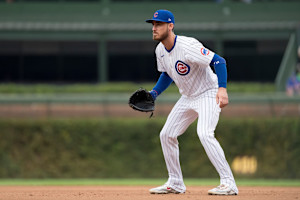
MLB News: Cody Bellinger Reportedly Traded to Yankees; Cubs Get Cody Poteet

Updated Top 25 MLB Free Agency Big Board After 2024 Winter Meetings
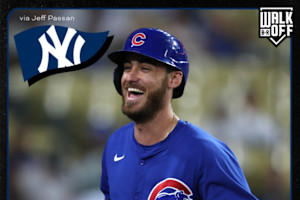
Cody Bellinger Yankees Trade Winners and Losers Including Aaron Judge, Cubs, More
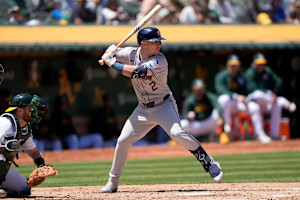
Astros' Alex Bregman's Top 10 Landing Spots in MLB Free Agency Amid Latest Rumors
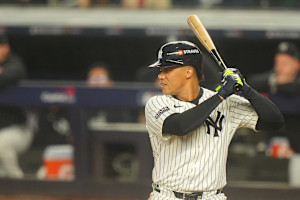
MLB Free-Agent Tracker 2024-25: Updates on the Latest Contract Signings and Trades
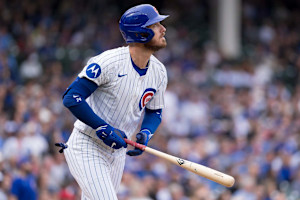
Yankees' Updated Starting Lineup, Payroll After Cody Bellinger Trade With Cubs
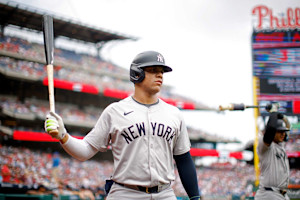
Ranking Yankees' Juan Soto's Top 10 Landing Spots Ahead of MLB Free Agency
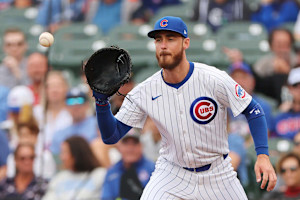
MLB Rumors: Yankees, Cubs Have Made 'A Bit of Progress' on Cody Bellinger Trade Talks

Projecting the Price Tags For Top MLB Free Agent of 2024-2025 Class
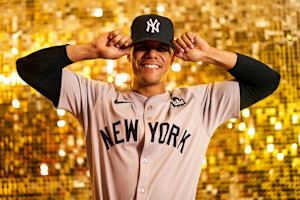
Contract, Team Predictions for Soto and Each MLB Player Who Rejected Qualifying Offer





























